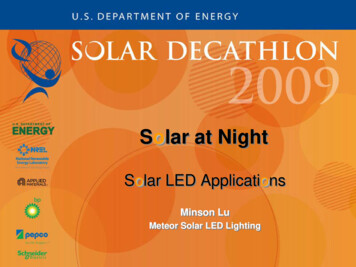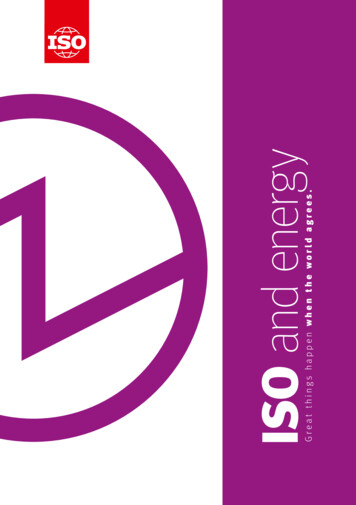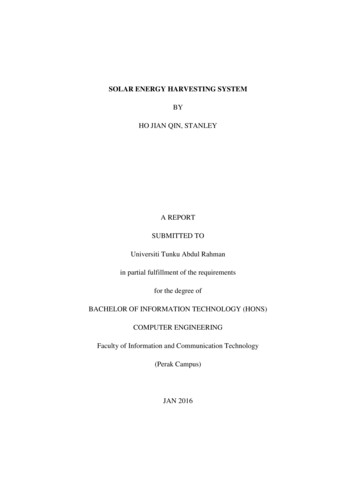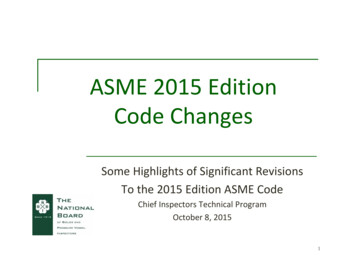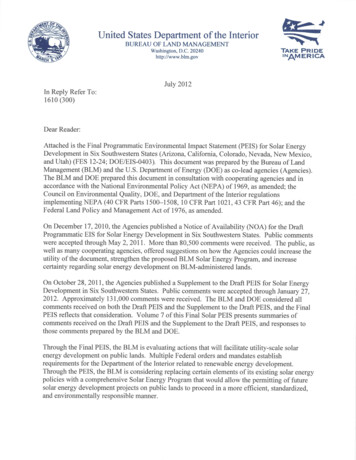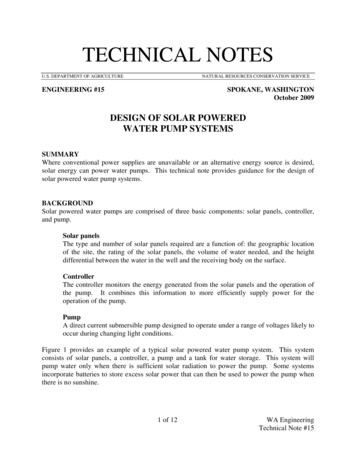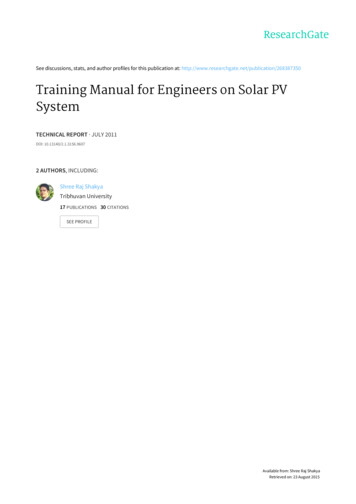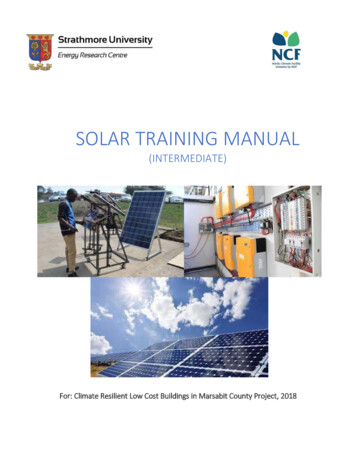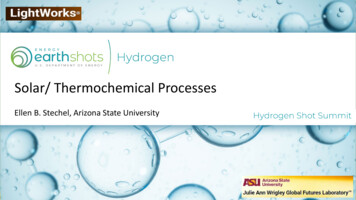
Transcription
Solar/ Thermochemical ProcessesEllen B. Stechel, Arizona State UniversityDOE SEPTEMBER 2021 HYDROGEN ENERGY EARTHSHOT SUMMIT: ADVANCED PATHWAYS ASU LIGHTWORKS ELLEN B STECHEL1
VALUING DIVERSITYASU CHARTERMeasured not by whom weexclude, but rather by whomwe include and how theysucceedINTENTIONALITY & MAKING APOSITIVE DIFFERENCE“Seal of Excelencia”Hispanic enrollment is nearly29,000 but ASU is notdesignated HSI ( 25%)DOE SEPTEMBER 2021 ASU LIGHTWORKS VISIONEnvisions a resilient andequitable energy futuresupported by innovations intechnology, policy, law,governance, and marketsTHE VALUE OF DIVERSITY &INCLUSIONDiverse teams are betterpositioned to unlockinnovation and solve hardHYDROGEN ENERGY EARTHSHOT SUMMIT: ADVANCED PATHWAYSproblems ASU LIGHTWORKS ELLEN B STECHEL2
VALUING DIVERSITY NOT ONLY FOR HUMAN CAPITALMULTIPLE VIABLE APPROACHESWOULD BE A GOOD THING 𝟏𝟏 𝟑𝟑𝟑𝟑. 𝟔𝟔 e to electrolysis is to usethermal energy Heat to do thework of breaking bondsCOMPETENCIESHigh temperature processesnot new to industryCapital assets can be highlycost-effectiveDOE SEPTEMBER 2021 SUPPLY CHAIN RESILIENCYTechnologies based on materials withwell-developed supply chainsSteel, Glass, Firebrick,ConcreteMade in AmericaNot all our eggs in the same basket ordependent on the same resourcesEXAMPLESRotary cement kilns operate at1450 C for yearsMassive scale: 4.1B t/yr and 0.1/kgFused glass 1700 C; Jet Engines 1600 CHYDROGEN ENERGY EARTHSHOT SUMMIT: ADVANCED PATHWAYS ASU LIGHTWORKS ELLEN B STECHEL3
SO HOW DOES THIS PATHWAY WORK?A SPECIALLY DESIGNED “ REDOX ACTIVE” MATERIAL “ BREATHES”OXYGEN AND “ CHARGES” SIMILAR TO A BATTERYEnergy In,Oxygen OutO2Relatively simple in conceptCyclical processActive material stays solidand notconsumedDOE SEPTEMBER 2021 HYDROGEN ENERGY EARTHSHOT SUMMIT: ADVANCED PATHWAYSH2H2O ASU LIGHTWORKS Oxygen In,Energy OutTwo stepsOther cycles andwith more stepspossible ELLEN B STECHEL4
WHAT IS IT GOING TO TAKE?KEY FEATURESRobust high-temperature processHeat input agnostic as long ascarbon-free and low-costPotential for low cost capital likeother thermal processing technologies 100/kWSPECIFIC CHALLENGESHigh temperature ( 1500 C)Low reduction partial pressure ofO2 ( 10 Pa or 100 ppm):separations challengeMaterial redox chemistryMaterials by design challengeOVERALL CHALLENGETECHNOLOGICAL REQUIREMENTSDevelop efficient, scalable, modularScalability - TWthermochemical reactors,Reactor and material Durabilityoptimized materials, andDesign for efficient energy utilization75 kWh/kgDOE SEPTEMBER 2021 optimized system configurationsDeveloping the workforceHYDROGEN ENERGY EARTHSHOT SUMMIT: ADVANCED PATHWAYS ASU LIGHTWORKS ELLEN B STECHEL5
VALUING INTEGRATION: NOT STANDALONEProjections of potentially 2.5 TWof H2 globally and multipleapplicationsIf 100,000 kg/day or 136 MW H2energy 18,000 such plants ( #airports)High quality jobsH2 hubs – production and useSame or related functional materials and processesDOE SEPTEMBER 2021 HYDROGEN ENERGY EARTHSHOT SUMMIT: ADVANCED PATHWAYScan be co-located – opportunity toreduce costs throughintegration, shared infrastructure,shared competencies ASU LIGHTWORKS ELLEN B STECHEL6
THANK YOU FOR YOUR KIND ATTENTIONTEllen.Stechel@asu.edu; Mobile: 1-505-400-4299I skate to where the puck is going to be and not where it has been.Wayne GretzkyDOE SEPTEMBER 2021 HYDROGEN ENERGY EARTHSHOT SUMMIT: ADVANCED PATHWAYS ASU LIGHTWORKS ELLEN B STECHEL7
Solar/ThermochemicalProcessesPRESENTED BYAnthony McDanielH yd r o g e n S h o t S u m m i t , S e p. 1 , 2 0 2 11This presentation does not contain any proprietary, confidential, or otherwise restricted informationSandia National Laboratories is a multimissionlaboratory managed and operated by NationalTechnology & Engineering Solutions of Sandia,LLC, a wholly owned subsidiary of HoneywellInternational Inc., for the U.S. Department ofEnergy’s National Nuclear SecurityAdministration under contract DE-NA0003525.
2Carbon-Free High Temperature Heat Enables Deeply EndothermicPathways to Large Scale H 2 ProductionH2 ½O2Ivanpah 2.4 GW thermalBoth CSP andNuclear currentlydesigned toprovide electricity G0 238 kJ/moleH2O (l)Concentrating solar-thermal power (CSP) can achieve processtemperatures T 1000 C.Conventional LWR nuclear reactors T 330 C.Advanced HTGR nuclear reactors T 850 C.USA 890 GW electricity in 2020
3Thermochemical Water Splitting CyclesM Ce, Sn, 1st row transition metal, Zn group metalMOx fluorite, perovskite, spinel, two-phase systemsTwo-step metal oxide cycles. Change oxidation state of a single elementStoichiometric or non-stoichiometricMay undergo phase changes (s, l, v, cryst)High process temperatures (T 1500 C)R. Perret, SAND Report (SAND2011-3622), Sandia National Laboratories, 2011.G. J. Kolb, R. B. Diver, SAND Report (SAND2008-1900), Sandia National Laboratories, 2008.S. Abanades, P. Charvin, G. Flamant, P. Neveu, Energy. 31, 2805–2822, 2006.F. Safari, I. Dincer, Energy Conversion and Management. 205, 112182, 2020.Multi-step cycles. Change oxidation state of two or more elementsMultiple chemical species reacting in each stepModerate process temperatures (T 1000 C)Several hundred cycles have been proposed
4Hybrid Thermochemical-Electrochemical Water SplittingCyclesNumber of steps and number of reacting species dependent on cycle complexity.Most known cycles designed for nuclear power industry. Tradeoff high process temperature for applied voltage to tailor cycle dynamics to available thermal resourceElectrochemical step is either oxidative or reductive, but NOT water electrolysis.
5Global Pursuits to Collaboration and Scaling UpHydrosol Plant project is the largest solarthermochemical H2 plant in the world. DLR (Germany), CIEMET (Spain), HYGEAR BV(Netherlands), and ELLINIKA PETRELAIA AE (Greece) Two-step metal oxide cycle @ 750 en/Joint solar thermochemical hydrogen R&D. ARENA (Australia) and Niigata University (Japan) Two-step metal oxide cycle @ 500 kWthIodine sulfur process for hydrogen production. Japan Atomic Energy Agency 100 NL/hr H2 test facility using industrial structural ing particle receiver design of solarthermochemical fuels. Sandia National Labs (USA) and DLR (Germany) Two-step metal oxide cycle @ 50 kWthTarget large scale production plants that offer advantages in efficiency and cost. Can thermochemical H2 challenge largest SMR facility in the world @ 345t 0498
6What is it Going to Take? Opportunities and Challenges.Overall challenge is to develop efficient, scalable, thermochemical reactors, optimizedmaterials, and optimized system configurations. Understanding behavior of materials in extreme environments Efficient heat integration (solar or nuclear) Novel methods for improving the efficiency of separations and heat exchange in harsh environmentsTwo-step MOx all thermochemical. Engineering for extreme process temperatures Discovering “good” redox active materialsMulti-step all thermochemical. Engineering for high process complexity due to multi-species and multi-phase chemistriesThermochemical – electrochemical hybrid. Similar issues as “multi-step all thermochemical” Efficient electrolytic integration
Thank You
QUESTIONS?8
Technology & Engineering Solutions of Sandia, LLC, a wholly owned subsidiary of Honeywell International Inc., for the U.S. Department of Energy’s National Nuclear Security Administration under contract DE-NA0003525. Solar/Thermochemical Processes

